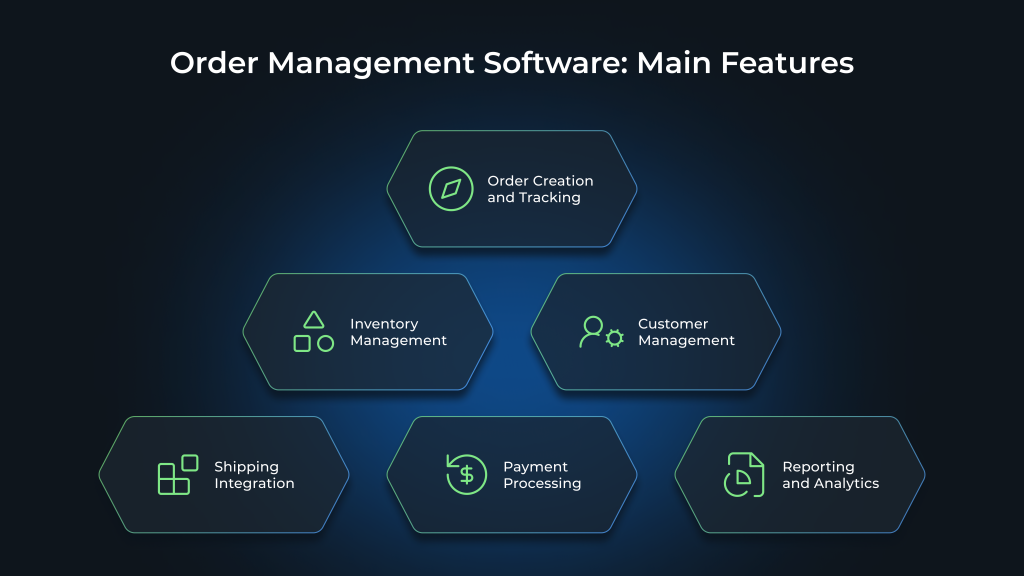In today’s fast-paced digital world, businesses are constantly searching for ways to streamline their operations and enhance their efficiency. One crucial aspect of running a successful business is managing orders effectively. An effective custom order management software can mean the difference between smooth operations and chaos. In this article, we will delve into the process of building a custom order management software that caters specifically to your business needs.
What is Order Management Software?
Before diving into the technical details of building an order management solution, it is essential to understand the fundamentals. A custom order management software (OMS) is a software solution that enables businesses to handle and track the entire order fulfillment process, from order entry to delivery. It serves as a central hub for managing customer orders, inventory, shipping, and accounting.
When it comes to running a successful business, efficient order management is crucial. An OMS provides businesses with a streamlined approach to handling orders, ensuring that each step of the process is executed smoothly and accurately. By utilizing an OMS, businesses can avoid the potential pitfalls of manual order processing, such as errors, delays, and customer dissatisfaction.
Definition and Function of an OMS
In simple terms, an OMS is a digital tool that allows businesses to manage their orders efficiently. It provides a comprehensive view of the order lifecycle and ensures that each order is processed smoothly and accurately. The primary functions of an OMS include order entry, inventory management, order tracking, payment processing, and data analysis.
Order entry is the initial step in the order management process. It involves capturing all the necessary information about the customer’s order, such as product details, quantity, and shipping address. This information is then stored in the OMS for further processing.
Inventory management is another critical function of an OMS. It allows businesses to keep track of their stock levels, ensuring that they have the necessary products available to fulfill customer orders. With an OMS, businesses can set up automated alerts for low stock levels, enabling them to replenish inventory in a timely manner.
Order tracking is an essential feature of an OMS that provides visibility into the status of each order. It allows businesses and customers to track the progress of an order, from the moment it is placed to the moment it is delivered. This transparency helps build trust and confidence in the business’s ability to deliver on its promises.
Payment processing is another crucial aspect of an OMS. It enables businesses to securely process customer payments, whether it be through credit cards, online payment gateways, or other payment methods. By integrating payment processing into the OMS, businesses can streamline the payment collection process and reduce the risk of errors or fraud.
Data analysis is a powerful feature of an OMS that provides businesses with valuable insights into their order management processes. By analyzing data such as order volumes, customer preferences, and order fulfillment times, businesses can identify trends, make informed decisions, and optimize their operations for better efficiency and customer satisfaction.
Importance of an Order Management Software
In today’s competitive business landscape, having a generic off-the-shelf OMS may not suffice. Every business has unique requirements that require tailored solutions. This is where an order management solution comes into play. With a custom-built OMS, you can align the system precisely with your business processes, improve operational efficiency, and gain a competitive edge.
An OMS allows businesses to have full control over the features and functionalities of the system. It can be designed to integrate seamlessly with existing software and systems, ensuring a smooth transition and minimal disruption to daily operations. Additionally, an OMS can be scaled and adapted as the business grows and evolves, providing long-term flexibility and sustainability.
Furthermore, an OMS enables businesses to address specific pain points and challenges they may face in their order management processes. Whether it’s automating manual tasks, implementing unique workflows, or incorporating industry-specific requirements, an OMS can be tailored to meet these needs effectively.
By investing in a custom order management software, businesses can optimize their order management processes, enhance customer satisfaction, and drive overall business growth. It is a strategic investment that can yield significant returns in terms of operational efficiency, cost savings, and customer loyalty.
Identify Your Business Requirements
Building a custom order management software starts with a thorough examination of your current order management process and identifying your specific business needs. We at Wesoftyou recommend conducting an in-depth analysis to ensure that your OMS addresses all pain points and fulfills your requirements effectively.
When it comes to identifying your business needs, it is important to consider various aspects of your operations. This includes evaluating your current order management process and determining the specific requirements that will make your OMS successful.
Evaluate Your Current Order Management Process
Before envisioning your ideal OMS, it is crucial to evaluate your existing order management process. This evaluation will help you identify the bottlenecks, inefficiencies, and areas that require improvement. By thoroughly understanding your current process, you can design a system that seamlessly integrates with your business operations.
During the evaluation phase, it is important to consider factors such as order processing time, inventory management, communication channels, and customer satisfaction. By analyzing these aspects, you can gain insights into the areas where your current process may be lacking and where improvements can be made.
Determine Your Specific Needs
Once you have assessed your current process, it’s time to define your specific requirements. This involves considering various factors that will shape the development of your OMS.
One important factor to consider is order volume. Depending on the size of your business and the number of orders you receive, your OMS should be able to handle the load efficiently. Scalability is also a crucial aspect to consider, as your business may grow over time and your order management software should be able to accommodate that growth.
Another factor to consider is product complexity. If your business deals with a wide range of products that have different attributes and variations, your OMS should be able to handle the complexities associated with managing these products. This includes features such as product categorization, SKU management, and inventory tracking.
Integration with other systems is another important requirement to consider. Your OMS should be able to seamlessly integrate with other systems such as inventory management, CRM, and accounting software. This integration will ensure smooth data flow and eliminate the need for manual data entry, saving time and reducing errors.
Reporting and analytics needs should also be taken into account. Your OMS should provide you with the necessary tools and capabilities to generate reports, track key performance indicators, and gain insights into your order management process. This will enable you to make data-driven decisions and optimize your operations.
By considering these factors and determining your specific requirements, you can lay a solid foundation for the development of your OMS. This will ensure that the system not only meets your current needs but also has the flexibility to adapt to future changes and challenges.
Design a Custom Order Management Software
After identifying your business needs, the next step is designing your order management solution. This phase requires careful consideration of key features and choosing the right software architecture that aligns with your requirements.
Designing an order management software involves more than just creating a basic framework. It requires a deep understanding of your business processes and goals. By taking the time to carefully design your system, you can ensure that it meets your specific needs and provides a seamless experience for both your team and your customers.
Key Features of an OMS

Based on our experience in software development, we recommend including essential features such as order creation and tracking, inventory management, customer management, shipping integration, payment processing, and reporting and analytics. However, the specific features you need will depend on your unique business requirements.
Order creation and tracking are vital components of any custom order management solution. This feature allows you to efficiently process incoming orders, track their progress, and provide real-time updates to your customers. By implementing a robust order tracking system, you can improve customer satisfaction and streamline your internal processes.
Inventory management is another critical feature to consider. By integrating your order management software with your inventory management system, you can ensure that you always have the right products in stock and avoid overselling or running out of popular items. This feature can help you optimize your inventory levels, reduce costs, and improve overall efficiency.
Managing customers is a fundamental element of any thriving business. By incorporating customer management capabilities into your order management system, you can efficiently monitor and utilize vital customer data, such as their information, preferences, and order history. This information empowers you to tailor the overall experience, execute precise marketing campaigns, and foster enduring relationships with your clientele.
Shipping integration is crucial for businesses that rely on timely and accurate delivery of their products. By integrating your order management software with shipping carriers, you can automate the shipping process, generate shipping labels, and provide tracking information to your customers. This feature can save you time and resources while ensuring that your customers receive their orders on time.
Payment processing is a fundamental feature of any order management solution. By integrating with secure payment gateways, you can offer a variety of payment options to your customers, including credit cards, digital wallets, and online banking. This feature ensures a smooth and secure payment process, reducing the risk of fraud and improving customer trust.
Reporting and analytics provide valuable insights into your business performance. By including robust reporting and analytics features in your order management software, you can track key metrics such as sales, inventory levels, customer satisfaction, and order fulfillment. This data can help you make informed business decisions, identify trends, and optimize your operations.
The Right Software Architecture
When designing your custom OMS, choosing the right software architecture is crucial. Select an architecture that can handle your anticipated order volume and support future growth. Consult with experienced software architects, like the team at Wesoftyou, to ensure that your system is scalable, secure, and able to integrate with your existing infrastructure.
The software architecture you choose will determine the overall performance, scalability, and flexibility of your order management solution. It is essential to consider factors such as the number of users, the complexity of your business processes, and the expected growth of your business.
Scalability is a critical aspect of software architecture. Your order management system should be able to handle increasing order volumes without compromising performance. By selecting a scalable architecture, you can ensure that your system can grow with your business and accommodate future expansion.
Security is another crucial consideration when choosing software architecture. Your order management solution will handle sensitive customer data, including payment information and personal details. It is essential to select an architecture that prioritizes data security and implements robust security measures to protect against potential threats.
Integration with your existing infrastructure is also a key factor to consider. Your order management software should seamlessly integrate with other systems and applications, such as your e-commerce platform, inventory management system, and customer relationship management (CRM) software. This integration ensures smooth data flow and eliminates manual data entry, reducing the risk of errors and improving overall efficiency.
Consulting with experienced software architects can provide valuable insights and guidance throughout the design process. They can help you evaluate different software architectures, assess their pros and cons, and recommend the best solution for your specific needs. By partnering with a trusted software development team, like WeSoftYou, you can ensure that your custom order management solution is designed to meet your unique requirements and set your business up for success.
Develop Your Order Management Software
Once the design phase is complete, it’s time to develop your custom order management software. This stage involves transforming your vision and requirements into a functional system that meets your business needs.
During the development process, our team of expert developers at Wesoftyou follows industry best practices and an agile development approach to ensure timely delivery and high-quality development. We understand the importance of a well-structured and efficient development process, and we strive to provide you with a system that exceeds your expectations.
Step-by-Step Development Process

The development process typically involves several stages, each playing a crucial role in the successful implementation of your order management solution.
Requirement Analysis: This stage focuses on understanding your business requirements and translating them into technical specifications. Our team works closely with you to gather all the necessary information and ensure that we have a clear understanding of your needs.
System Design: Once the requirements are defined, our developers create a detailed system design. This includes defining the system architecture, database structure, and user interface design. We pay special attention to scalability, performance, and user experience to ensure that your OMS is efficient and user-friendly.
Coding: In this stage, our developers write the code that brings your custom order management software to life. We use modern programming languages and frameworks to ensure a robust and maintainable codebase. Our team follows coding best practices and adheres to coding standards to ensure the quality and readability of the code.
Testing: Testing is a crucial part of the development process. Our team performs various types of testing, including unit testing, integration testing, and system testing, to identify and fix any bugs or issues. We also conduct user acceptance testing to ensure that the system meets your requirements and functions as expected.
Deployment: Once the development and testing phases are complete, we deploy your order management system to the production environment. Our team ensures a smooth deployment process and provides ongoing support to address any issues that may arise.
System Security and Compliance
Security and compliance are paramount when it comes to OMS development services. Data breaches can be detrimental to any business, leading to financial loss and damage to reputation. At Wesoftyou, we prioritize system security and adhere to industry standards to ensure that your OMS is robust, secure, and compliant with relevant regulations.
Our team implements various security measures, such as encryption, access controls, and secure authentication mechanisms, to protect your data from unauthorized access. We also conduct regular security audits and vulnerability assessments to identify and address any potential security risks.
In addition to security, we also ensure compliance with relevant regulations, such as the General Data Protection Regulation (GDPR) and the Payment Card Industry Data Security Standard (PCI DSS). Our developers are well-versed in these regulations and implement the necessary measures to ensure that your order management solution meets all the compliance requirements.
By prioritizing security and compliance, we provide you with an order management solution that not only meets your business needs but also protects your valuable data and ensures the trust of your customers.
Test Your Order Management Software
Before going live, rigorous testing of your order management software is essential. Testing ensures that the system functions as intended and identifies any potential issues or defects that need to be addressed.
When it comes to testing your order management software, the importance of thoroughness cannot be overstated. A comprehensive testing process is crucial to validate the functionality and performance of your system. By conducting various tests, you can ensure that your OMS meets your specific requirements and provides a seamless experience for both your team and customers.
System Testing
System testing is a critical step in the development and implementation of your order management solution. It involves testing the system as a whole to ensure that all components work together seamlessly. This type of testing helps identify any potential issues or defects that may arise during real-world usage.
One of the primary goals of system testing is to validate the functionality of your OMS. This includes testing features such as order processing, inventory management, and customer communication. By thoroughly testing these functionalities, you can ensure that your system performs as expected and meets the needs of your business.
In addition to functionality testing, system testing also includes performance testing. This involves testing the system’s ability to handle a high volume of orders and transactions. By simulating real-world scenarios and stress-testing the system, you can identify any performance bottlenecks and optimize your OMS for optimal performance.
Types of Testing Methods
There are various testing methods available to evaluate the effectiveness and reliability of your custom order management system. The choice of testing method will depend on factors such as budget, time constraints, and the complexity of your OMS.
Manual testing is one of the most common testing methods used in software development. It involves manually executing test cases and verifying the system’s behavior against expected results. Manual testing allows for greater control and flexibility, making it suitable for small-scale projects or when specific scenarios need to be tested.
Automated testing, on the other hand, involves using specialized software tools to automate the execution of test cases. This method is particularly useful for large-scale projects or when repetitive tests need to be performed. Automated testing can save time and effort, allowing for more efficient testing processes.
Continuous integration testing is another testing method that focuses on integrating and testing code changes as they are made. This method ensures that new code additions or modifications do not introduce any regressions or conflicts with existing functionalities. Continuous integration testing helps maintain the stability and reliability of your OMS throughout the development process.
At WeSoftYou, we understand the importance of selecting the most appropriate testing approach for your custom order management software. Our experienced team can help you determine the best testing methods based on your project requirements, budget, and timeline. With our expertise, you can ensure that your OMS undergoes thorough testing to deliver a reliable and efficient solution for your business.
Implement Your Order Management Software
After successfully developing and testing your order management solution, the final step is implementation. This involves training your team and putting your system into action
Training the Team
Transitioning to an OMS requires proper training for your team. Train your employees on how to use the new system effectively. Provide comprehensive documentation and offer ongoing support to ensure a seamless transition and adoption of the system.
Monitoring and Updates
After implementation, it’s crucial to monitor the performance of your OMS. Regularly evaluate its effectiveness and address any issues that may arise. As your business evolves, you may need to update and enhance your system to accommodate new requirements or technologies.
Conclusion
Investing in a custom order management software tailored to your specific business needs can result in significant benefits. From streamlining your order management process, improving efficiency, ensuring accuracy, to gaining a competitive advantage, an OMS can transform your business operations and help you stay ahead in the market.
At WeSoftYou, we have extensive experience in software development, including OMS development services for businesses of all sizes. We understand the importance of a tailored solution and can assist you throughout the development process, from requirements gathering to implementation and support.
FAQ
An Order Management Software (OMS) is a software solution that simplifies and optimizes the process for receiving, tracking, and fulfilling customer orders. It aids in managing orders, sales, inventory, and fulfillment. OMS is particularly common for businesses that deal with a significant volume of orders, ensuring efficient order processing and delivery tracking.
— Enhanced Order Processing: OMS solutions streamline order processing, reducing errors and improving efficiency.
— Inventory Management: OMS helps manage inventory levels, reducing excess stock and preventing stockouts.
— Customer Satisfaction: Improved order tracking and faster delivery enhance customer satisfaction and loyalty.
— Integration: OMS can integrate with other business systems, ensuring a unified and efficient workflow.
Yes, a custom Order Management Software (OMS) can integrate with other systems you use. OMS solutions are designed to be flexible and adaptable, allowing businesses to connect them with various systems for streamlined operations. This integration capability is typically achieved through Application Programming Interfaces (APIs) that enable custom connections to other systems.
For example, an OMS can integrate with e-commerce platforms, marketplaces, ERP (Enterprise Resource Planning) systems, accounting applications, and even shipping carriers. This integration enhances the OMS’s functionality, enabling it to sync inventory levels, manage orders across different sales channels, and streamline the entire order processing and fulfillment workflow.
The time required to build an Order Management Software can vary depending on factors like complexity, features, and the development team’s expertise. Typically, it may take several months to develop a comprehensive OMS. The process includes requirements analysis, design, development, testing, and deployment, with smaller projects taking a few months and larger, more complex systems potentially taking a year or more. The specific timeline should be determined in consultation with the development team.
If you’re considering building an order management software for your business or have any questions, feel free to contact us at WeSoftYou for a free consultation or project estimation. We’ll be more than happy to assist you in finding the best solution for your business needs.





















